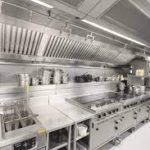The light emitting diodes or LEDs are your buddies if you want a well-lit home without spiking up your utility bills. Compared to an incandescent bulb, LEDs use about 25%-80% less energy and can last up to 25 times longer. Therefore, switching to an energy-efficient light bulb like LEDs may help you save $75 annually. That’s the main reason why a lot of homeowners prefer using LEDs as artificial light in the house.
Today, LEDs come in a wide range of light. You can choose between the soft and warm, cool and crisp, or the funky ones which change colour from time to time. You can even get Neon LED lights and signs (more info here) which can be a really attractive way to jazz up your house. Whichever type of LED light you use, you can be sure that it delivers the up-lighting, down-lighting, accent lighting, and general lighting you need in the kitchen.
To get the most sensible ways of using LED lights in the kitchen, we asked for advice from the Superdraft Pty. Ltd. Here’s what their Perth architects and interior designers said:
Accentuate floating shelves

(source)
The LED lights installed on and under the floating shelf accentuates this slim and long storage under the kitchen cabinets. Though the shelf has a slim profile, the lights helped it stand out from the dark backsplash and cabinetry.
Toekick lights

(source)
Here, the LEDs accentuate the boundary between the floor and the kitchen cabinetry. Use this if you want a nighttime light that is not as intense as your ceiling lights.
In addition, toekick lighting also helps people with impaired vision and dementia. The light can guide them whenever they walk into the kitchen and go down from a high bar stool.
Countertops and kitchen islands

(source)
To make the glass counter top of a kitchen island standout, ask your designer to install LED lights under it. It will create a dramatic illumination, elevating the island’s translucent surface.

(source)
If you don’t have a glass counter top but you have the waterfall kitchen island, try putting led lights under it. It brightens up the area under the risers which don’t receive enough light. This also accentuates the bar area.
Highlight architectural features
Your LEDs can make architectural features stand out from the rest in your kitchen and dining area. Take note on how the light makes the tray ceiling pop out of the white ceiling.
General kitchen lighting

(source)
A lot of kitchens use recessed LED lights as their primary source of artificial light in the kitchen. If you have an open floor plan home, installing recessed lights enables you to do area lighting. If you’re cooking, turn on most of the lights in the kitchen area. Leave the lights in the living area off. If there’s nothing blocking the light from the kitchen, it will still illuminate the other areas. This maximizes your lighting and saves a couple dollars for you.
It’s bright, durable, and easy to maintain. The homeowner won’t feel any hassle because these bulbs rarely overheats and can last up to 20 years.
Upper cabinet lighting

(source)
This one works if your kitchen cabinets that don’t touch the ceiling and you don’t want that dark space to be seen. The ceiling also reflects the light, subtly illuminating the other parts in the kitchen. Completely brighten up the space with a fluorescent bulb.
Undercabinet lighting

(source)
Your LED lights are best installed as under cabinet lighting. It’s your task light whenever you prepare food in the kitchen. In addition, LEDs rarely overheat so you won’t feel uncomfortable working under it.
Task Light inside drawers and cabinets

(source)
The space inside your drawers and cabinets lacks lighting. There are times that you can’t see the items that are placed at the back of these storage areas. With motion sensor LED tape light, you’ll lighten up your storage every time you open them.
Replace your light fixtures
Finally, if your ceilings are too high for recessed lights, go for pendant lights. Most of the pendant lights sold today are powered by energy-efficient bulbs. If not, change it before you use it.
It’s important to get that lighting right
The kitchen is the busiest part of the house and it needs a lot of layers of light to illuminate t properly. You’re gonna need the balance between natural and artificial lighting to do this. Under artificial lighting, you saw that you will need general kitchen lighting, task lighting, and if you like, some accent lighting. If you’re not using LEDs, you’re most likely paying a huge amount for utility. Of course, all of these layers of light need to go well together. Uncoordinated light causes eyestrain and does not make your interiors better.
About The Author
Charlene Ara Gonzales is a design writer from Superdraft Australia. Their team of architects are the leaders in residential design in the land down under. Follow them on Facebook, Instagram, and LinkedIn.





No Comments